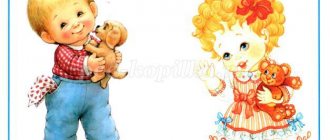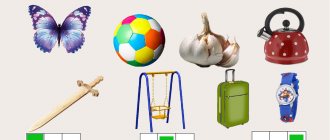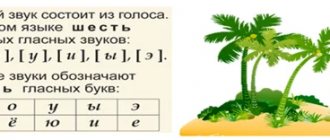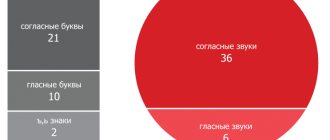LiveInternetLiveInternet
Lesson on ZKR in a preparatory speech therapy group.
Author: Elena Yurievna Khokhlova , teacher - speech therapist, MDOU DS KV N7, Kukharivka village, Yeisk district.
Goals : to develop phonemic hearing and perception in children, to consolidate the skills of clear pronunciation of the sounds S, S in words, phrases, sentences; learn to give comparative articulatory and acoustic characteristics to sounds; - learn to determine the place of sound in a word, do a sound analysis of words, divide words into syllables, determine the number of syllables in a word and their order, lay out a diagram; - agree on nouns. with adjective, noun with verbs, numbers. with noun, to form plural. number of nouns in the genitive case; - develop coherent speech, general and fine motor skills, visual coordination, attention, memory, thinking. Equipment: a plot picture on a winter theme, subject pictures in the names of which have the sounds S, S, cards-schemes, chips for laying out sound patterns, sound rulers, strips for laying out syllables, a ball, paper snowflakes, sound houses, Sound gnomes. Progress of the lesson. I. _ Org. moment. (Children stand in the center of the group) Speech therapist: Guys, what time of year is it now? (Winter). Let's tell you how our fingers spend time together in winter. 1. Finger gymnastics. Performing movements in accordance with the text. We went for a walk in the yard. One, two, three, four, five. (Bend one finger at a time) They sculpted a snow woman, (Imitate the sculpting of lumps) They fed the birds crumbs, (“Crush bread” with all fingers) Then we rode down the hill (Run the index finger of your right hand along the palm of your left hand) And we also rolled around in the snow. (Put your palms on the table, first on one side, then on the other) Everyone came home covered in snow (Dust off your palms) They ate the soup and went to bed. (Make movements with an imaginary spoon, put your hands under your cheeks) 2. Speech therapist: The one whose name begins with a vowel sound, with a hard consonant sound, with a soft consonant sound will sit down. (Children sit down.)
II . Main part. 1. Speech therapist: Guys, today we will continue our journey and go to the city of Zvukograd. (Draw the children’s attention to the sound houses.) Sounds live in the houses. Let's remember what sounds live in the red house? In the blue house? In the green house? (Children's answers after each question).
2. Speech therapist: And also in the sound houses there live Dwarfs - Sounds, but we will find out which of them we will meet today. And now, listen to the riddles that the Dwarfs have prepared for you. (Riddles in which the sound /S/ appears at the beginning of the word. Children guess, the speech therapist displays the corresponding guessing pictures). - The motley fidget, the long-tailed bird, the talkative bird, the most talkative. (Magpie)
- Stroking - caresses, Teasing - bites. (Dog)
— The blue airplane sat on a white dandelion. (Dragonfly)
- Although I’m called sugar, I didn’t get wet from the rain. Large, round, sweet in taste. Get to know me, my name is...... (Beets)
— The star spun in the air a little, sat down and melted on my palm. (Snowflake)
Speech therapist: Guys, look at the pictures, say the words, highlighting the first sound with your voice. What is the first sound you heard in all these words? (Children: sound /S/). Let's take a mirror and pronounce the sound S. In what position are the lips, teeth, tongue? Place your palm to your mouth, feel the air is cold or warm, does it flow freely? Place your palm on the neck, does it hum or not? (Children answer each question, characterize the sound. Conclude that the sound /S/ is consonant, hard, unvoiced.)
3. Speech therapist: Today we will get acquainted with the sound /С/ and its brother - the sound /Сь/. We hear the sound /Sy/ in the words: tit, sieve, orange, goose, letter. (The corresponding pictures are displayed). Guys, name more words that contain the sounds /С/, /Сь/. Playing with a ball. (The child catches the ball and says the word.) Guys, who guessed which of the Sound Dwarfs we will go to visit? (to green and blue) The sound boys' names are Sanya and Senya. Determine which gnome is called what. (Blue - Sanya, green - Senya and explain why). 4. Game “Slam and Stomp”. Speech therapist: Let's play the game “Clap and Stomp” together with the Sound students. I say words with a hard consonant /С/ - you clap, with a soft consonant /Сь/ - you stomp.
5. Pronouncing pure sayings. Speech therapist: Let's please the Zvukovichki and talk to them in pure language. Sa-sa-sa - a wasp is sitting, Sy-sy-sy - the wasp has a mustache, Su-su-su - we saw a wasp
Si-si-si - carry the scythe, Si-si-si, bring the scythe. Etc.
6. Game “Where the sounds are hidden.” (On the table each child has a picture with the sounds /С, Сь/). Speech therapist: Determine the place of the sound in the word and put the picture under the corresponding diagram. (The speech therapist checks and corrects errors).
7. Speech therapist: Sound students love sledding. What else can you do on a sled? (Children: ride, slide, roll down, ride....) (Laying out the sound diagram of the word SLEDGE from sound chips and on sound lines. Analysis).
9. Speech therapist: Let's rest a little. Dynamic pause.
10. Speech therapist: Let's show our Sound students how we can divide words into syllables: a) cheese, elephants, trays - we clap; b) juice, owl, cabbage - laying out diagrams. How else can we determine how many syllables are in a word? (Remember: how many vowel sounds are in a word, so many syllables).
11. Game “One - Many” (words with sounds /С, Сь/ according to the model) One round wheel - many round wheels, One sharp braid - many sharp braids... etc. 12. Game “Let’s count objects from 1 to 5.” (Use pictures) 1 owl, 2 owls, 3 owls, 4 owls, 5 owls…..
13. speech therapist: Guys, while we were counting, the first sound /S/ was lost in the words. Let's substitute the sound and determine what word we get. ...anki, ...okol, ...ahar, ...unduk.
14. Speech therapist: While you and I were looking for the sound, snowflakes fell on the ground. (The speech therapist hands out paper snowflakes to the children.) What are snowflakes like in winter? (Children: white, fragile, light, fluffy...) Visual coordination exercise “Snowflakes”. (Follow with your eyes in accordance with the text.) We saw snowflakes and played with snowflakes. Snowflakes flew to the right, Eyes looked to the right. Snowflakes flew to the left, Eyes looked to the left. The wind lifted the snow up and dropped it to the ground. The eyes look up and down. All! They lay down on the ground. We close our eyes, our eyes rest. 15. Guys, there is a picture in front of you. Let's make suggestions on it. So that our Dwarfs learn more about winter. (Children make sentences about winter based on the picture) 16. Summary of the lesson.
https://www.ivalex.vistcom.ru/zanatia1396.html
Synopsis of the frontal lesson “Sounds S and S”
Summary of frontal lesson
2nd preparatory group
Topic: Differentiation of sounds [s] and [c']
Goal: learning to act according to verbal instructions
Tasks:
ABOUT:
— learn to compose a sentence with a given word and analyze it
- practice differentiating sounds [s] and [s'] based on clarity
- practice determining the place of sounds [s] and [s'] in a word
K\r:
- develop coherent speech through retelling the story “An Incident at the Border”
- develop phonemic awareness
IN:
- develop a sense of independence and self-control
H0od lessons:
1. Org. Moment.
- Hello guys! The one who answers my question correctly will sit down. What day of the week is it today? What day of the week was yesterday? What will it be like tomorrow?
2. Main part.
- Today in class we will remember the sounds s and s', try to compose a sentence and a diagram for it, together we will get acquainted with the story “An Incident at the Border” and even try to tell it ourselves.
— What sounds did you get acquainted with in the last lesson? (s and s)
- Sound From what? (consonant, voiceless, hard) And his brother, the sound S? (ag, deaf, soft)
— The sounds s and s love to travel. And this time they go on a big journey to a magical land on 2 locomotives. The first locomotive contains only those words that contain the sound S. And the second locomotive contains only those words that contain the sound s. The first carriages are occupied by those pictures in the name of which the sound comes first, the second carriages are occupied by those with the sound in the middle of the word, and in the last carriage are those pictures in the name of which the sound comes last. Let's try to load passengers.
(Pictures and words are offered, the child must identify the locomotive and its place in it.)
Elk, letter, hay, goose, boots, chair, nose, fox, bowl, bus, orange.
2. Well done! So we rode a steam locomotive to the station and then we need to change transport, you can guess what we will use next, you can guess for yourself.
- Who can tell me what kind of bird In the sky, like the wind, rushes, White draws a trail behind it in the blue azure? And the pilot is driving it! - What is this? - … (Airplane)
— To take off, we need to make a sentence about an airplane. Suggest that I find out about the plane. Tell us about it.
- e.g. The plane is flying high.
— How many words are there in a sentence? (3) Are there any prepositions? (no) Let's make an outline of the sentence.
- what is the first word? (plane), the second? (flying), the third? (high) and at the end we put a dot.
- Well done! Now we can continue our journey by plane.
3. Physical exercise.
- If you hear the sound S in a word, jump, and if you hear the sound S, squat.
4. “An Incident at the Outpost”
“We flew to a fairy-tale city and the old gnome invites us to listen to the fascinating story “An Incident on the Border.”
- What a story? (for questions)
- Look, each of you has an illustration for the story. Let's make a movie with you.
(I indicate an excerpt from the story)
- Whoever has a suitable picture, come out and put it on the board. All agree?
- And now, let's tell the story ourselves using the illustrations. (First, what happened then, how it all ended)
5. Summary of the lesson.
- What did we do today? What did you like! You did well today, but you should try a little more to make it even better next time.




